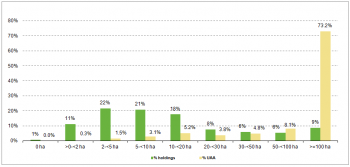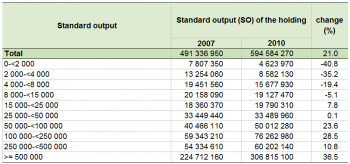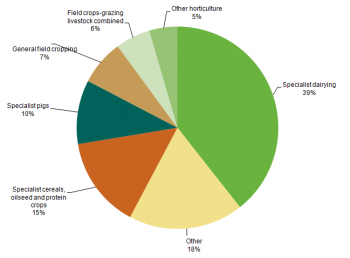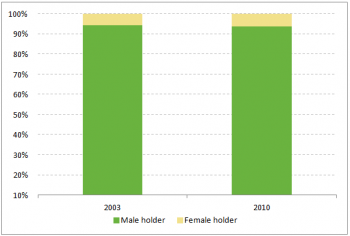Archive:Agricultural census in Estonia
This article has been archived.
This article is part of a series of country-specific essays on the results of the European Union (EU) Farm structure survey (FSS) 2010. The FSS collects information on the structural characteristics of the agricultural holdings (land use, livestock and labour force) and is carried out by all European Union Member States every 10 years as an Agricultural census, with two or three additional, intermediate sample surveys carried out in-between. In Estonia, the FSS 2010 was the first Agricultural census to be carried out according to European legislation. The present analysis of the farm structure includes a comparison with the 2003 FSS, the first sample survey conducted in the country according to EU regulations.

Source: Eurostat (ef_kvaareg) (ef_ov_kvaa) (demo_pjan) and FSS, 2003 and 2010

Source: Eurostat (ef_kvaareg) (ef_ov_kvaa)

Source: Eurostat (ef_kvftreg)

Source: Eurostat (ef_lu_ovcropaa) (ef_oluaareg)

Source: Eurostat (ef_lu_ovcropaa) (ef_oluaareg)

Source: Source: Eurostat (ef_pmhouscatlaa)
Main statistical findings
Key indicators
In 2010 there were 19 610 agricultural holdings in Estonia (see Table 1). After 2003 the number of agricultural holdings halved (-47 %). Although the reduction in the number of farms is common throughout the EU-27, the remarkable drop recorded in Estonia suggests structural changes are undergoing in the agricultural sector of the Baltic country.
According to the FSS 2010 data, an opposite tendency was recorded by the utilised agricultural area (UAA). Indeed, after 2003 an increase of 18.3 % in the UAA was reported so that in 2010 it represented 20.8 % of the whole Estonian territory and it covered 940 930 hectares. As a result, a large increase in the average size of the agricultural holdings was observed, as this indicator grew from 21.6 ha per farm in 2003 to 48 ha in 2010. In addition, an increase of 20 % on the average UAA per inhabitant was recorded: values moved from 0.6 hectares per inhabitant in 2003 to 0.7 ha in 2010 due to the increase in the UAA and a minor fall in the population (-1.2 %).
Among the Baltic countries, Estonia proved to be the one recording the smallest values of UAA: in 2010 it was one of the few Member States below the 1 million of hectares threshold. Also in terms of the number of holdings, Estonia recorded the lowest value among the Baltic countries and one of the lowest within the EU-27. On the contrary, the average size of the Estonian farms was found to be among the highest of the European Union.
When looking at the animal livestock expressed in livestock units (LSU), it can be observed that in 2010 there were 306 280 LSU recorded in Estonia (see Table 1): this is one of the smallest values among the EU Member States and it represents a decrease of 6.1 % when compared to 2003 data.
As the number of farms halved within the 2003-2010 timeframe, the number of persons working in agriculture fell by 43.4 %: from 92 500 to 52 340. Accordingly, in 2010 the population working in agriculture represented 8 % of the economically active population of Estonia.[1]
Agricultural holdings
Agricultural holdings were found to be rather small in Estonia. According to the FSS 2010 data, 72 % of them had less than 20 hectares of UAA and accounted for 10 % of the UAA of the whole country. On the contrary, a large share (73 %) of the total UAA belonged to a small percentage of agricultural holdings (9 %): the farms with a size of 100 hectares or more.
When compared to the FSS 2003 data, in 2010 the number of farms with 100 hectares or more of UAA increased from 1 090 to 1 720 (+58 %) in Estonia - a common tendency throughout the EU-27. On the other hand, the holdings with less than 2 hectares were the ones that suffered the sharpest fall, from 7 510 in 2003 to 2 210 in 2010 (-71 %). Indeed, the population of small holdings continuously dropped since 2001 as they ceased their activity due to economic and social reasons.[2]
Economic size of the farm
In 2010, the economic size of all the Estonian agricultural holdings was EUR 594.6 million, a value calculated by adding all the standard output (SO) per hectare of crop and per head of livestock of the farms. Compared to the FSS 2007 value (EUR 491.3 million), the 2010 data showed an increase of 21 %, which to a great extent reflected the growth of the economic size of the biggest classes of farms. In particular, the agricultural holdings with an economic size of EUR 500 000 or more recorded the highest increase (36.5 %), while those with an economic size of less than EUR 1 000 suffered the largest fall (-40.8 %).
In Estonia, the holdings with an economic size of EUR 500 000 or more represented 52 % of the total standard output of the agricultural holdings in 2010.
Agricultural holding by main type of farming
In terms of the main area of production, holdings specialised in general field cropping were found to be the most common in Estonia. According to the Agricultural census 2010, they represented about 25 % of the total number of holdings. Agricultural holdings classified as specialised in dairy farming accounted for 10 %, while those focusing on cereals, oilseed and protein crops accounted for 9 %, the very same percentage shared by farms specialised in sheep, goats and other grazing stock. Finally, holdings specialised in various crops and livestock combined accounted for 8 %.
The hierarchy of the holdings looks different when regarded in terms of the economic size. Indeed, when using the SO for measuring the main type of farming, 39 % of the population of the farms appeared to be specialised in dairying. Furthermore, agricultural holdings whose production was focused on cereals, oilseed and protein crops accounted for the 15 %, whereas the contribution of those specialised in pigs was 10 % of the total SO of the Estonian agricultural holdings. Farms specialised in general field cropping accounted for 7 %; the ones specialising in field crops-grazing livestock combined accounted for 6 % while those specialised in other horticulture shared 5 %.
Land use
The utilised agricultural area (UAA) is the total area taken up by arable land, permanent grassland and meadow, permanent crops and kitchen gardens used by the holdings, regardless of the type of tenure or of whether it is used as a part of common land.
In Estonia, the UAA increased by 145 290 hectares after 2003 (18.3 %), indicating the value of 940 930 hectares in 2010. Nonetheless, the relative weight of its main components did not change remarkably over the 2003-2010 timeframe, with the arable land and the permanent grassland and meadow representing still about the 99 % of the UAA in 2010: the combined share of the two categories of land used actually moved from 98.8 % in 2003 to 99.5 % in 2010.
In particular, when comparing the FSS 2010 data with the FSS 2003 data, the share of the area occupied by arable land showed a large increase (19.5 %), from 535 550 hectares to 640 040 hectares. Slightly smaller was the growth of the permanent grassland and meadow: from 250 400 hectares in 2003 to 296 060 ha in 2010 (+18.2 %).
Arable land
In Estonia, the land that is regularly worked (ploughed or tilled), generally under a system of crop rotation, represented 68 % of the total UAA in 2010 (see Table 3): it accounted for 67.3 % of the UAA in 2003. Despite its stability, same changes occurred in the structure of the arable land as the production of industrial crops doubled its weight over the total UAA, accounting for 10.6 % in 2010. Also, the follow land increased its weight over the total UAA reaching 4.5 % in 2010: it accounted for the 3.3 % of the Maltase UAA in 2003. On the other hand, while growing in absolute terms, cereals and fodder crops showed small decrease in terms of their share over the total UAA.
Permanent grassland and meadows
Between 2003 and 2010 the area of permanent grassland and meadows grew by 18.2 %: from 250 400 ha to 296 060 ha. Nonetheless, in terms of land use its weight did not change, since in both reference years it was found to account for the 31.5 % of the total UAA in Estonia.
Livestock
Statistics on livestock use two different units of measurement: the number of heads (number of animals) and the livestock units (LSU). The latter makes the comparison between different types of livestock possible.
According to the 2010 data, there were 0.2 LSU per inhabitant in Estonia, the same value that was registered in 2003. Nonetheless, the population of livestock decreased by 6.1 % over the period 2003-2010. When looking into the different types of livestock, the situation appears more complex (see Table 4). The sheep almost doubled, from 4 690 LSU in 2003 to 8 710 LSU in 2010, and the number of pigs increased by 11.8 %. On the contrary, figures for the poultry (-17.8 %), the goat (-15.9 %), the cattle (-14.2 %) all decreased between 2003 and 2010. The cattle and the poultry represented by far the most important type of livestock in 2010, together they accounted for the 88.5 % of the whole Estonian LSU: they accounted the 73 % of the LSU of the Baltic country in 2003.
The number of agricultural holdings with livestock decreased by 58 % over the 2003-2010 period, from 22 780 to 9 680. Since the number of farms with livestock dropped more than the number of LSU, a large increase in the average LSU per holding was registered: indeed, over the 2003-2010 period, this indicator doubled, moving from 14 LSU per farm to 32 LSU.
According to 2010 data the population of small farms fell while big farms increased in number. In particular, only two classes of agricultural holdings increased in number compared to 2003 data: those with 50 to 99 LSU grew from 210 to 270 (25.8 %), and the ones with 500 LSU or more increased from 120 to 130 (12.2 %). On the other hand, the farms with less than 5 LSU decreased by 67 %, while farms with 5 to 10 LSU decreased by 52 % and those with 10 to 15 LSU reduced by 43.3 %.
Labour force
In the 2003-2010 timeframe, a general fall in the labour force employed in the agricultural sector was observed in Estonia. Indeed, 52 340 persons were working on farms in 2010, a value which represents a fall of 43.4 % in comparison with the 2003 data, when 92 500 persons were working in the agriculture sector. This figure slightly changes when the analysis takes into account the labour force in terms of the annual work unit (AWU), reaching -33.1 %. Indeed, in absolute terms the labour force shifted from 36 710 AWU in 2003 to 24 550 AWU in 2010.
When comparing the FSS 2010 data with the FSS 2003 data, a decrease in the AWU directly employed in the agricultural sector is observed (-33 %).
Management practices
Type of tenure
In Estonia, according to the 2010 data, the majority of the UAA (52.7 %) was worked by the tenants: 495 620 hectares. On the contrary, 377 980 hectares of UAA (40.2 %) belonged to the farmers who actually worked on that land. The remaining 7.2 % was recorded as being under shared farming or other modes – this is an agricultural area utilised in partnership by the landlord and the sharecropper, under a written or oral share-farming contract, or it is an area utilised under other modes of tenure.
Irrigation
Due to its meteorological condition, as in most of the northern European countries, irrigation is of no relevance in Estonia. In 2010, there were 460 hectares of irrigable area in Estonia, representing the 0.05 % of the total UAA. Furthermore, 330 hectares were found to be irrigated at least once a year; this figure does not account for the area of kitchen gardens (1 710 ha) and represents the 0.04 % of the UAA of the Baltic country.
Animal housing
According to the FSS 2010 data, there were 4 620 holdings raising 241 030 heads of cattle in Estonia; 79.2 % of those proved to host cattle in stanchion tied stable with solid dung and manure (see Table 7). Moreover, 19.9 % were classified as hosting cattle in loose housing with solid dung and liquid manure (65 700 places).
Other gainful activities
According to the data of the Agricultural census 2010, there were 2 650 holdings with other gainful activities in Estonia (see Table 8). Representing a small share of the whole population of agricultural holdings (13.5 %), these farms recorded activities other than farm work, directly related to the holding and having an economic impact on the holding.
Information on other gainful activities was collected in the form of eleven category types depending on their characteristics. According to the FSS 2010 data, the most common one was contractual work (860 holdings), which was classified as contractual non-agricultural work (500 holdings) and contractual agricultural work (490 holdings). When analysing data on other gainful activities it must be noted that holdings involved in more than one gainful activity were counted more than once.
Organic farming
Organic agriculture is an ecological production management system that promotes and enhances biodiversity, biological cycles and soil biological activity. It is based on the minimal use of off-farm inputs and on management practices that restore, maintain or enhance ecological harmony.
In Estonia, the number of agricultural holdings practicing organic farming was growing steadily over the 2003-2010 timeframe (see Table 9): while there were only 280 holding conducting organic farming in 2003, 1 060 of them were recorded in 2010. Accordingly, the UAA under organic farming increased from 16 130 hectares in 2003 to 82 390 hectares in 2010.[3]
Data sources and availability
Methodological notes
As reported in the National Methodological Report, Statistics Estonia was the official body responsible for undertaking the Census of agriculture in 2010. The department concerned was the Agricultural Statistics Department. The Agricultural Census 2010 was the sixth one done in Estonia: the previous ones were conducted in 1919, 1925, 1929, 1939 and 2001. While in the Agricultural census 2001 the national threshold was used, the new threshold was applied after that and the 2001 data were recalculated accordingly.
Survey on agricultural production methods (SAPM)
In 2010 a unique survey was carried out together with the Agricultural census: the Survey on agricultural productions methods (SAPM). This survey collected data at regional level needed to establish agri-environmental indicators as indicated in COM final 508/2006 and to evaluate the greening of the Common agricultural policy.
Data were collected according to specifications listed in Annex V of Regulation 1166/2008, namely data on tillage methods, soil conservation, landscape features, animal grazing, animal housing, manure application, manure storage and treatment facilities and irrigation.
Reference period
The Agricultural census 2010 was conducted from 1 September to 15 November 2010; the reference date was 1 September 2010.
Threshold for agricultural holdings
Whereas no samples were used for collecting data for the Census of Agriculture 2010 and the Survey on Agricultural Production Methods (SAPM), a threshold was applied in both surveys. Accordingly, the agricultural holding was defined as a unit where there is at least one hectare of utilised agricultural area or where agricultural products are produced mainly for sale.
In case of holdings with less than one hectare of utilised agricultural area, the physical threshold was used in order to determine potential holdings producing mainly for sale. The physical threshold was used if there was no information about products produced for sale. The threshold was as follows: at least 3 cattle; 10 pigs, sheep or goats; 10 swarms of bees or 100 heads of poultry; 0.5 ha of fruit and berry plantations; 0.3 ha of fresh vegetables; 0.2 ha of nursery; 0.01 ha of outdoor flowers, crops under glass or arable land seeds.
Common land
Common land – which is the land that does not directly belong to any agricultural holding but on which common rights apply – is non-existent in Estonia. Indeed, even if some holdings graze their animals in the same area, they can say which part of this area belongs to them.
Geo-reference of the holding
The geo-coordinates of the holdings were taken from the cadastre system. Afterwards, for confidentiality reasons they were rounded into a 5 by 5 km grid.
Economic size
From FSS 2007 onward, the Standard output, a new classification of the economic size of the holding, has been implemented. The SO has replaced the standard gross margin (SGM) used before. Nonetheless, for comparability reasons, in FSS 2007 both classifications are available.
Volume of irrigation water
As indicated in the National Methodological Report, the question about the volume of water used for irrigation was included in the questionnaire. Then, if the holders could not estimate this volume, they were asked for a general description of how often and how much irrigation was used. Also imputation on the basis of the data received was used.
The amount of water does not include water used in greenhouses and kitchen gardens: these areas constituted 0.004% and 0.181% – respectively – of utilized agricultural area.
Context
European Commission Rural development policy aims to improve competitiveness in agriculture and forestry, improve the environment and the countryside, improve the quality of life in rural areas and encourage the diversification of rural economies.
As agriculture has modernised and the importance of industry and services within the economy has increased, so agriculture has become much less important as a source of jobs. Consequently, increasing emphasis is placed on the role farmers can play in rural development, including forestry, biodiversity, the diversification of the rural economy, in order to create alternative jobs and environmental protection in rural areas.
The FSS continues to adapt in order to provide timely and relevant data to help analyse and follow these developments.
See also
- Agricultural census 2010
- All articles on Estonia
- All farm structure articles by country (2007)
- Farm structure statistics
Further Eurostat information
Publications
- Agriculture, fishery and forestry statistics — Main results – 2010-11 - 2012 edition
- Farm Structure in Estonia - 2007 - Statistics in focus 83/2008
- Farm Structure in Estonia - 2005 - Statistics in focus 14/2006
Main tables
- Agriculture, see:
- Farm structure: historical data (1990-2007) (t_ef)
Database
- Agriculture, see:
- Farm structure (ef)
Dedicated section
Methodology / Metadata
- Farm structure (ESMS metadata file — ef_esms)
- Methodological Report – FSS 2007 Estonia
- Methodological Report – FSS 2010 Estonia
Source data for tables and figures (MS Excel)
Other information
- Regulation 1166/2008 of 19 November 2008 on farm structure surveys and the survey on agricultural production methods and repealing Council Regulation 571/88
- Regulation 1200/2009 of 30 November 2009 implementing Regulation 1166/2008 on farm structure surveys and the survey on agricultural production methods, as regards livestock unit coefficients and definitions of the characteristics
External links
Notes
- ↑ A value calculated over the total number of active people aged 15 to 64, as it is reported by the 4th quarter of 2010 of the EU Labour force survey (LFS) Population by sex, age, nationality and labour status (1 000). This value is not the percentage of agricultural labour, it represents the number of persons involved in agricultural activities (even if they are not full time workers and they have other activities than agriculture)
- ↑ As stated in the National Methodological Report, page 14.
- ↑ Due to methodological reasons, data from the FSS 2005 and 2007 present differences up to 2% compared with data from the official Organic Farming Register








